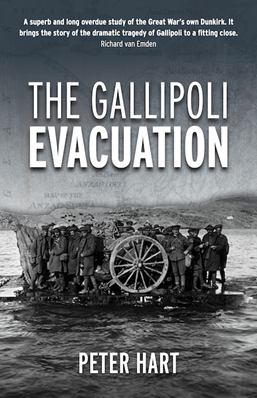Withdrawing your forces while ‘in-contact’ with the enemy is a challenging military manoeuvre.
To suggest that it be done in conjunction with a reverse amphibious landing would probably result in receiving a ‘Fail’ in any staff college exercise. The successful withdrawal of Allied forces from the Gallipoli Peninsula in late 1915 and early 1916 remains one ‘bright spot’ in an otherwise costly, and some say, futile campaign. Yet, there have been few accounts of that final chapter of the Allies’ attempt to ‘knock Turkey out of the war’. The Gallipoli Evacuation fills this gap.

Hart was the oral historian at the Imperial War Museum for 39 years, during which time he interviewed thousands of veterans. He has written several books on the First and Second World Wars, but has been obsessed with the Gallipoli campaign and is a well-regarded tour guide to the Gallipoli battlefields.
From the outset of the campaign, the Allies’ attempts to move inland to support the navy in penetrating the Dardanelles defences were stymied by a resolute Ottoman defence. The landing of an additional British Division at Suvla Bay in August failed to break the stalemate. Hart examines the many factors that then led to the decision to withdraw the force. Those factors, and the process by which the decision was made in both military and political circles, were more complicated than many realise. The Navy believed that another effort to force the Dardanelles might still be possible with its improved minesweepers. Even when that course was dismissed, there was an argument, that by maintaining a force on Cape Helles, the Cape could be developed into a second Gibraltar to control the Dardanelles. The Allies, however, could not continue expending resources on the campaign, particularly with other theatres developing in Mesopotamia and North Africa stretching logistics to the limit.
The decision to abandon the campaign was Lord Kitchener’s to make after General Sir Charles Monro had concluded that “a complete evacuation was the only wise course to pursue”. Even when the decision was made to withdraw, the operation was going to be operationally complex and tactically daunting. Many feared that as much as a third of the force might be lost because the Turks would maintain close contact. The odds against success were even higher for the Allied forces on Cape Helles who were to be withdrawn a week after Suvla and Anzac and the Ottomans had become fully alert to the Allied actions.
While the book provides insights into the strategic context for the withdrawal, its main focus is on the organisation, subterfuge and luck that combined to affect an extraordinary disengagement in the face of an enemy that was in some places only a matter of yards away. Every day, the Turks moved up more guns, threatening to blast to pieces the flimsy piers, breakwaters and blockships that acted as makeshift harbours to feed and supply tens of thousands of men. Winter was approaching and a tremendous storm imposed immense damage and loss of life. The detailed evacuation plans were brilliant, especially the early introduction of silent periods. Yet, it was still a close-run thing. A spell of bad weather in the final days might have destroyed the flimsy piers, leaving thousands trapped helpless should the Turkish guns open up and their infantry overwhelm the remaining thinned-out Allied forces.
Hart blends context and events with personal anecdotes. Utmost secrecy, cunning and ruse were needed to ensure the enemy did not realise thousands of men with guns and equipment were leaving and grasp the opportunity to massacre the ever-diminishing Allied presence. This infuses the story with an increasing sense of tension. While the book is consistently enjoyable, and humorous in places, the author shows respect for the men discussed consistent with the serious view he takes of the topic.
Hart’s account, like most others of the Gallipoli campaign, suffers from a paucity of sources from the Ottoman perspective. While he is able to include a few quotes, the larger questions remain of whether the Ottomans knew what was occurring and chose to let the evacuation proceed without serious interference. Hart partially makes up for this with a discussion based on his extensive knowledge of the campaign and the personalities of its actors, but he also might have benefitted from consulting Harvey Broadbent’s Gallipoli: The Turkish Defence (The Miegunyah Press, Melbourne, 2015) and Edward Erickson’s The Ottoman Campaign (Pen & Sword, UK, 2010).
The Gallipoli Evacuation includes several black and white images, three basic maps, a bibliography and an index. Hart has written a fascinating book that conveys the risks and demands of the operation. There are not many accurate and informative non-fiction historical books written over a century after the event that leave the reader gripped and barely able to put down until complete, but this is certainly one of them.
Contact Marcus Fielding about this article.






